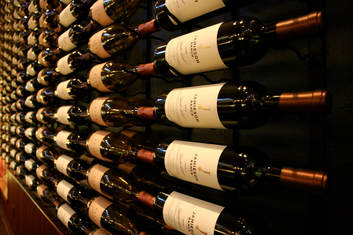|
I used to be very intimidated when ordering wine at a restaurant, especially any fancy joint with a long wine list. After several years of wine travel, living in Sonoma, and earning an official wine certification, I've finally mastered the dreaded wine ordering process. But you shouldn't have to get formal training to feel at ease with ordering outside your comfort zone. So take to heart my core message: IT'S NOT YOUR FAULT! Really. Go easy on yourself... It's. Not. Your. Fault. The difficulty and intimidation felt when ordering wine is the fault of the restaurant and their service staff. Most establishments in which I've dined go about their wine service entirely wrong. Even in some restaurants with a full-time, trained sommelier, the wine ordering process is an abysmal failure. Guests are never given enough time to consider the wine list. The server requests a drink order far too quickly and then promptly confiscates the wine menu. Aforementioned server rarely knows a darn thing about wine. If they call for backup from a sommelier, that individual heaps on the discomfort by speaking in industry jargon and suggesting the second-most expensive bottle on the list. I've developed a surefire strategy to confidently order wine, make your dining experience smoother, and feel like a boss doing so. No matter your level of wine knowledge, even if you're a self-proclaimed expert, this strategy will win. Here Are My Tricks#1 - Accept the fact that wine in restaurants is absurdly expensive. The bar is more profitable than the kitchen. This is common industry knowledge. Restaurants rely on profits from alcohol sales to subsidize the food prep, so the drink margins are larger. Also, a fully-stocked bar and deep wine list is a pricey inventory to keep provisioned. Therefore, bottles of wine are priced at 2-3 times retail cost. Here's a secret: wine-by-the-glass is usually priced at the wholesale cost of the whole bottle! So that $40 bottle of Chardonnay which costs you $8 by-the-glass... costs the restaurant $8. Sorry to be the bearer of bad news, but accepting this reality will make you more comfortable ordering wine. #2 - Do a bit of research prior to dinner. These days, you always read the online menu before choosing a restaurant, right? Well, take an extra minute to peruse the wine list if they also have it posted. Just as you know which dishes are immediately enticing, certain wines will jump out at you. If the list is obscure or concentrated to one region about which you know very little, such as the wines of Croatia, you'll know to ask for guidance. (What the heck is Plavac Mali?!) You'll also get a feel for the value of the wines and will be prepared to spend accordingly. Furthermore, consider the wine preferences of your fellow diners. If they aren't old friends, you may not know what wines they like, whether they are willing to split the cost, or if expensive wines make them uncomfortable. Before or immediately upon your arrival to the restaurant, and ask your companions whether they will partake in the wine and if they have any general preferences/aversions. It's the courteous thing to do. #3 - Consider bringing your own wine. Outside of wine-producing regions, this isn't a very common practice. But if the wine list is complete garbage, consider bringing your own bottle of wine. How can the untrained eye judge if the restaurant wine list is terrible? If you can recall seeing the majority of the brands for sale at your supermarket, then the list is an insult to fine dining. Feel free to bring your own bottle, which the restaurant will charge a corkage fee to serve to you. (Usually $15-30). If the corkage policy isn't explicitly listed on their website menu, then call ahead and ask. Be warned: it's incredibly tacky to bring a wine which is featured on the wine list, and doing so may even be prohibited by the restaurant. On the other hand, if you're celebrating a special event and want to bring your favorite wine despite the fact that the wine list is great, go for it. Just be sure to order pre- or post-dinner drinks from the menu. The restaurant will appreciate that, and if you also buy a bottle of wine off the menu, they just may waive the corkage fee. #4 - Elect a wine delegate. When you sit down in a dining group of 2-6 people, designate one person to order the wines by the bottle. (Larger groups are a whole different ballgame.) Etiquette-wise, first right of refusal should go to the individual who chose the restaurant or can reasonably be considered the "host". Otherwise, nominate the person perceived to have the most wine knowledge. They'll not only feel honored to choose the wine, they'll enjoy doing so. #5 - Pick your meal first. There’s nothing I hate more than a waiter handing me an extensive wine list and then returning for my drink order less than five minutes later. Set the wine list aside unless you have something very specific in mind (or if you already chose your bottle per Trick #2). First select your meals, then go back to the wine list. If you want an aperitif drink while deliberating, get a cocktail or a glass of bubbly to start. You can then order your bottle of wine after you place your food order. This restructuring of the ordering process will allow you time to consider food and wine pairing based upon the table's dishes. It'll also take the pressure off your table mates to make a selection compliant with your wine choice. #6 - Confidently say how much you are willing to spend on a bottle. It’s okay to get the cheapest bottle of wine on the menu if that’s what you want to drink. Per Trick #1, you've already come to grips with the reality that restaurant wine is overpriced. But don't be a cheapskate who settles for the cheapest bottle no matter what. If you've enlisted the help of the server or sommelier, confidently give them some price guidance. Don't be embarrassed if your budget is on the low end. Giving your sommelier wine style criteria without a budget range is certain to end in a costly suggestion. Be proud of the fact that most occasions don't call for an expensive wine. #7 - State what you like. Asking a sommelier for a random wine recommendation is as bewildering as asking a department store clerk for underwear recommendations: they can't tell what you have on and have no frame of reference for what you'd like. If you have a favorite wine you drink each week, tell them that. If you're out for a special occasion, inform them of the best wine you've ever had. And if there is a type of wine that totally disgusts you, reveal that, too. These points of reference will be incredibly instructive to landing on the perfect wine for the night. #8 - Ask questions. Have you never heard of Mencia from Ribeira Sacra? Don't know the difference between Riesling Kabinett and Riesling Auslese? Have no idea where Taurasi or Minervois are located, or what grape varieties they contain? No problem! If the server/sommelier suggests a wine from an unknown place or a varietal you've never heard of, just ask about it! Don't be shy to admit you know nothing about the wine or place. Give them an opportunity to educate you. And then, don't just settle for the facts. Ask the server why they are suggesting the wine and what makes it great. If they can answer those questions with certainty and without condescension, then they've demonstrated their excellent wine service training. Trust their advice and try something new! If they can't answer those simple questions, then they've proven they are inadequately trained and don't know an iota more than you about wine! Perhaps they should go back to working at Applebee's, where "House Red" and "House White" are as complicated as it gets. Now make that reservation, dominate that wine list, and enjoy your night out!
0 Comments
Your comment will be posted after it is approved.
Leave a Reply. |
Blog
Other non-travel ramblings on wine and business. Archives
December 2018
Categories
All
|
|
All content is original property of Vineration unless otherwise noted.
Not permitted for reproduction. © COPYRIGHT 2019. ALL RIGHTS RESERVED.
|



 RSS Feed
RSS Feed

